Anticodons - Study guides, Class notes & Summaries
Looking for the best study guides, study notes and summaries about Anticodons? On this page you'll find 207 study documents about Anticodons.
All 207 results
Sort by
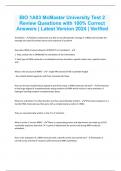
-
BIO 1A03 McMaster University Test 2 Review Questions with 100% Correct Answers | Latest Version 2024 | Verified
- Exam (elaborations) • 28 pages • 2024
-
- $13.49
- + learn more
Translation - Cellular components are able to read the genetic message in mRNA and translate the message into specific primary amino acid sequence of a protein How does tRNA structure allow for SPECIFICTY in translation? - 1. Plays critical role in ENABLING the translation of the information 2. Each type of tRNA molecule is not identical and can translate a specific codon into a specific amino acid What is the structure of tRNA? - - single RNA strand (70-90 nucleotide length) - four doub...
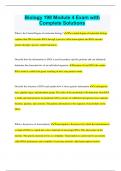
-
Biology 198 Module 4 Exam with Complete Solutions
- Exam (elaborations) • 11 pages • 2024
- Available in package deal
-
- $9.99
- + learn more
Biology 198 Module 4 Exam with Complete Solutions What is the Central Dogma of molecular biology? The central dogma of molecular biology explains that DNA encodes RNA through a process called transcription and RNA encodes protein through a process called translation. Describe how the information in DNA is used to produce specific proteins and can ultimately determine the characteristics of an individual organism. because of your DNA the certain RNA strand is coded from genes resulti...
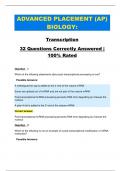
-
ADVANCED PLACEMENT (AP) BIOLOGY: Transcription 32 Questions Correctly Answered | 100% Rated
- Exam (elaborations) • 15 pages • 2023
- Available in package deal
-
- $12.00
- + learn more
ADVANCED PLACEMENT (AP) BIOLOGY: Transcription 32 Questions Correctly Answered | 100% Rated Question 1 Which of the following statements about post-transcriptional processing is true? Possible Answers: A methylguanine cap is added to the 3' end of the mature mRNA Exons are spliced out of hnRNA and are not part of the mature mRNA Post-transcriptional hnRNA processing prevents RNA from degrading as it leaves the nucleus A poly-A tail is added to the 5' end of the mature mRNA Cor...
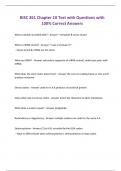
-
BISC 261 Chapter 10 Test with Questions with 100% Correct Answers
- Exam (elaborations) • 8 pages • 2024
-
- $12.49
- + learn more
hat is double stranded DNA? - Answer * template & sense strand What is mRNA strand? - Answer * uses U instead of T - Sense strand & mRNA are the same What are tRNA? - Answer anticodons (opposite of mRNA strand): make base pairs with mRNA
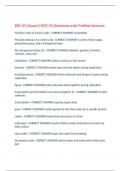
-
BIO 101 Exam 2 WCC 93 Questions with Verified Answers,100% CORRECT
- Exam (elaborations) • 7 pages • 2024
-
- $15.99
- + learn more
BIO 101 Exam 2 WCC 93 Questions with Verified Answers Function units of nucleic acids - CORRECT ANSWER nucleotides Physical makeup of a nucleic acid - CORRECT ANSWER 5 carbon ribose sugar, phosphate group, and a nitrogenous base the nitrogenous bases are - CORRECT ANSWER adenine, guanine, thymine, cytosine, and uracil replication - CORRECT ANSWER makes a copy of a Dna strand helicase - CORRECT ANSWER breaks open the dna ladder during replication dna polymerase - CORRECT ANSWER ...
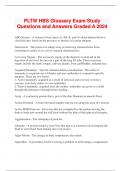
-
PLTW HBS Glossary Exam Study Questions and Answers Graded A 2024
- Exam (elaborations) • 31 pages • 2024
- Available in package deal
-
- $16.49
- + learn more
ABO System - A system of four types (A, AB, B, and O) which human blood is classified into, based on the presence or absence of certain antigens. Abstraction - The process of taking away or removing characteristics from something to reduce it to a set of essential characteristics. Accessory Organs - The accessory organs of the digestive system aid in the digestion of our food, but are not a part of the long GI tube. These accessory organs include the teeth, tongue, salivary glands, liver, ...
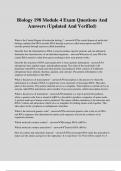
-
Biology 198 Module 4 Exam Questions And Answers (Updated And Verified)
- Exam (elaborations) • 5 pages • 2024
- Available in package deal
-
- $10.49
- + learn more
, thymine, guanine, and cytosine. The genetic information is the sequence of nucleotides in the DNA. What is the process of transcription? - answerTranscription is the process by which the information in a strand of DNA is copied into a new molecule of messenger RNA. This takes place in the nucleus. The genetic material serves as a template. Transcription is carried out by an enzyme called RNA polymerase and a number of accessory proteins called transcription factors. What is the process o...

-
AQA A level biology paper 1 Questions & Answers 100% Correct
- Exam (elaborations) • 23 pages • 2024
- Available in package deal
-
- $12.99
- + learn more
Describe how oxygen in the air reaches capillaries surrounding alveoli in lungs - ANSWERTrachea and bronchi and bronchioles; Down pressure gradient; Down diffusion gradient; Across alveolar epithelium; Across capillary endothelium/epithelium; Difference between species richness and index of diversity - ANSWERSpecies richness measures only number of (different) species / does not measure number of individuals; Explain how cellulose molecules are adapted for their function in plant cells...
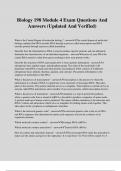
-
Biology 198 Module 4 Exam Questions And Answers (Updated And Verified)
- Exam (elaborations) • 5 pages • 2024
- Available in package deal
-
- $10.49
- + learn more
Biology 198 Module 4 Exam Questions And Answers (Updated And Verified) What is the Central Dogma of molecular biology? - answerThe central dogma of molecular biology explains that DNA encodes RNA through a process called transcription and RNA encodes protein through a process called translation. Describe how the information in DNA is used to produce specific proteins and can ultimately determine the characteristics of an individual organism. - answerbecause of your DNA the certain RNA str...
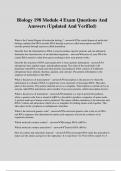
-
Biology 198 Module 4 Exam Questions And Answers (Updated And Verified)
- Exam (elaborations) • 5 pages • 2024
- Available in package deal
-
- $10.49
- + learn more
Biology 198 Module 4 Exam Questions And Answers (Updated And Verified) What is the Central Dogma of molecular biology? - answerThe central dogma of molecular biology explains that DNA encodes RNA through a process called transcription and RNA encodes protein through a process called translation. Describe how the information in DNA is used to produce specific proteins and can ultimately determine the characteristics of an individual organism. - answerbecause of your DNA the certain RNA str...

Did you know that on average a seller on Stuvia earns $82 per month selling study resources? Hmm, hint, hint. Discover all about earning on Stuvia


